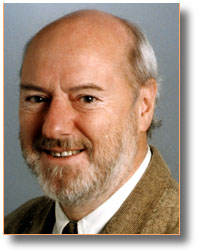|
Designing Design Research 2 :
The Design Research Publication
| DDR2 |
 |
 |
 |
 |
 |
 |
 |
| SPEAKERS |
Alec Robertson |
Dr Tom Cassidy |
Prof. Nigel Cross |
Prof. Martin Woolley |
Prof. J Woudhuysen |
Prof. Jeremy Myerson |
Dr R Glanville |
SUMMARY TRANSCRIPT OF DISCUSSION POINTS
Question
From: John Cook, Head of Department of Industrial & Graphic Design , DMU
How can design research interact with the student learning experience?
Prof. James Woudhuysen
For a start I want chalk and talk, and IT. I think design research has
to be significantly visual for it to qualify since 50% of the term says
design. Therefore outcomes such as exhibits have to have that 'delight
factor', otherwise we may as well be in accountancy or whatever.
Question
From: Professor James Woudhuysen
I have done non-refereed works in industry but I would be sued if I
revealed them to anyone. I therefore seem to retain an image as a
pulp fiction merchant so what can be done about this in RAE
terms?
Professor Martin Woolley
PhD studies occasionally stray into this area and methods can be employed.
The RAE panel is 'closed' and can therefore be exposed to sensitive
material. There may be a problem with feeding such items into the student
learning experience.
Professor Nigel Cross
I welcome articles with direct contact with industry, and we are also
looking for (in Design Studies) work outside a scientific journal,
although we do not stray far from this.
Dr Tom Cassidy
The RAE should not be the reason why we do research. It should be done
because you want to... you love to do it.. and you want to teach students
the latest material.
Professor Martin Woolley
The RAE is 'peer group assessment' and takes place in a small arena. It is
not just what is on paper but 'what is known' in the field by the
assessors. Those who play the 'numbers games' are easy to spot.
Dr Ranulph Glanville
At undergraduate level in design education, the end of a design project is
important - it
should be reflected upon and summarised. Reflection using the 'project crit
can improve the student learning experience. This can also introduce
them to the wider role of what research can do.
Question: Piotr Kozak, Course Director, Product Design, Central St
Martins School of Design
What are the trends in British design?
Dr Tom Cassidy
'Designer Empowerment' - To empower creative designers who are often
misunderstood, even thwarted, by technicians, engineers, etc. To give
more credibility to research in the design community and to provide tools
to empower designers in manufacturing.
Question:(Course Director, Product Design, Central St Martins
School of Design.)
Research as a tool for cultural investigation is needed, where there is
investigation as to a products
immaterial qualities. For example, the 'virtual world' is receiving much
press, but what are the implications for the physical world, where fashion
meets product. What are the consequences on our culture does research have?
Alec Robertson
More and more consultancies are reporting that their
work increasingly involves design of services and strategy, as well as,
and sometimes
before, the design of products. John Stoddard of IDEO in a recent Design
Week feature expressed this view, and he also criticised design
education for not taking on a wider perspective at the last IDATER
Conference in Loughborough. For example, 4D
design focuses on the immaterial in
relation to dynamic form, with and without new technology, and this has
yet to make an impact on design education.
Prof Jeremy Myerson
Counter trends are appearing to the 'virtual world' as the more we
discuss it, the more a group of designers discuss 'physicality' -
the revival of craft - interaction of the traditional role of the craft
object with the world - symbolic - tactile qualities.
A designers role is to make a technological world livable in. We can
all get carried away with technology but I think there is a backlash
- and that is a trend.
Question: Piotr Kosak, (Course Director-Product Design, Central St
Martins School of Design)
What are the consequences on our culture in design does research have?
Prof James Woudhuysen
Design research needs to have a practical element in it. At DMU we call
this 'design research pragmatism' where we consider the 'real world'
relationship of research to counter the navel gazing.
As for trends,
there is a need for center of research excellence for materials and
design.
A positive trend:
I see is a willingness to have more fun'.
Alarming trends:
to publish too much.
there is a loss of willingness to accept
responsibility and ownership of what is done.
Question: Prof. Gillian Crampton Smith (RCA)
Traditional design research has concentrated on the functional side and
engineering, and not the cultural side. Universities are a place where
the cultural side of design research can be done. This area is difficult
for design groups. There is a need for more speculative design research
and for Universities to do the kind of design research that is difficult
to do elsewhere. Is not this what design research should be doing more?
Alec Robertson
'Design Research' has neglected research of cultural issues in design, in
preference to for example engineering design and product development issues.
Some performing arts have had a particular
problem of capturing the full richness of experimental cultural aspects
within research 'documentation'. 4D design research has a similar problem.
Question
Piotr Kosak, (Course Director-Product Design, Central St Martins)
What about 'speculative design as an RAE output?
Prof Martin Woolley
Designed artefacts as a research activity output can be considered if
they get to production. A new area of research which has yet to be
embraced is the graduate designer finding their way into
entrepreneurial activity. My apprenticship assumed that a job would
be found somewhere. So research is needed into how entrepreneural activity
operates and how to prepare a graduate for this activity.
Alec Robertson
'Speculative design' work is I believe one of the Cinderellas of design
research. It can in my view be viewed as 'strategic' research or
even 'basic' design research where
new principles are explored and these are then fed into applied design
projects. Therefore in some circumstances an artifact designed does not
have to get into production to be a valid research outcome in my view. Many
designers find their way into advanced product research units and all
their work can be considered research. If such work is 'exhibited'
then certainly should count as a research publication or one sort. Only a fraction of
the designs/artefacts prototyped in experimental design will get into
production and we should recognise the value of these and their
contribution to knowledge.
Prof. Nigel Cross
Exploratory practical work is good alternative to
conventional
practice. I do not go along with a view often promoted in higher education
that
teachers of design have to be practitioners. Conventional design practice
is NOT research so there is no advantage in teachers doing it from
the research perspective. The Design Research Society could be more
active in providing a variety of publication formats for exploratory
design work.
Dr. Ranulph Glanville
The idea of practical work as a refereed publication is being taken
seriously in Australia. A product design can for example by submitted for
inclusion in a kind of catalogue. The submission is sent to international
referee and if accepted it is included. Publication of it in visual form in
this catalogue is considered to be equivalent to a 'research paper'. This
is the kind of new publication we should consider.
Prof. Malcolm LeGrice, Central St Martins.
The exhibition is an undeveloped 'publication source'. There is a real
need for a set of exhibition venues to be established for practitioner
design researchers. This is something the Design Research Society could
encourage.
Alec Robertson
Exhibition of work is important for new dynamic 4D designs such as
multimedia because so much is
lost when reduced to a photo and text in a journal, more so than even
traditional 3D
designs such as furniture. You have to experience a new design and
appreciate its full richness to access its contribution to the body of
design knowledge. Research papers in 2D print media fail to communicate
the value of such designs adequately.
Prof Brian Allison (ARIAD)
Is the climate for research changing in design practice? Specifically
as:
research building on work done before
communicating work done?
In my experience with the ARIAD it has been very difficult to get people to
submit entries especially from industry. A C change is needed. In this
context does industry do research?
Prof. Jeremy Myerson
Yes, industry does research, but 95% of design research documented and made
available is done in the Universities. Industry has not a culture of
'sharing', but one of 'hoarding' information. We have to provide bridges
and outlets for industry with the media and show something is to be gained
by sharing. The refereed journal has a lot to do here. In the medical
profession journals such as the Lancet and BMJ distill and synthesize
information based
on their contents for the media into a digestable form. Design researchers
and their journals have to learn to do this.
Question: Prof Brian Allison
There is a vast array of materials available for design practitioners but
they do not read it. There is much 're-inventing the wheel' going on
because designers are not aware of what is already available. The BBC is
not the forum for this as it is aimed at a mass audience and not the
profession. So why do not designers have a professional attitude to
research and find out what has been done through the literature.
Prof Jeremy Myerson
This has been a perceived problem for many years and I have heard the
criticisms of designers many times before. It is because they want
information in a form that they want it. It is no use complaining that
they do not read research papers. They are the audience and it is for
researchers to provide their results in an acceptable form.
Sales of illustrated design books are going through the roof. They
have a roundup of what design in going on now, which serves them on their
terms and not design research terms.
Prof James Woudhuysen
The design community can barely read. Jeremy has corned the market in
design coffee table books. What would be really interesting is if the
Martin Woolley RAE research culture could meet the coffee table book market.
Design has been 20 years in the wilderness but suddenly as Prime
Minister Blair mistakes business for show business we have seen designers
at the forefront of public attention with the London Millennium Dome et al.
Alec Robertson
A first step is to make it as easy as possible for potential
research information to be located
irrespective of the form of publication. The ARIAD (Allison Research
Index for Art and Design) is a good example of such a facility.
Question :Ben Shaw (Royal College of Art)
How do you view practice as design research?
Dr Tom Cassidy.
I mentioned we have some excellent consultancy work being done and we are
trying to ensure this is thoroughly documented during the design process
to results can be made available to make a contribution to the body of
knowledge.
Alec Robertson
A design has to add something new to the body of design
knowledge to be defined as design research. Something practitioners might
say 'I can use that in my designs'. If an exhibit of a new design is
seen by those respected at the top of the profession as in the RAE, and
they agree
it is new, then that is one way of deciding if a design is a research
publication. If it gets another
formal recognition, for example as a patent, that is another. If it
is featured in a 'respected' design magazine or book then perhaps
it could be too, as it is most likely featured because the editor, with an
overview of the contemporary design, feels readers need to know about
it and it is contributing something to the body of design knowledge.
Question :Denis O'Brien.
Multidisciplinary research is growing and 'lean engineering' is one new
way of creating a product. Research is needed into the social processes
that encourage creativity between people. These are rich processes.
It is said that what can be modelled on a computer is modelled by
computer. It is said that what is measurable is not worth
doing, and what can be spoken about can only be put into words. It is
however the conversations, the 'mood culture' with people that is
the key to high creative outcomes
Do we not need to do research beyond just artefacts?
Prof James Woudhuysen
I cannot agree that we need fewer 'numbers'. Many designers are not only
illiterate, but they are not numerate either. There is always the need for
numerate information on prices, markets, users etc. in briefing design.
This is essential for good design.
Alec Robertson
The design of social organisation for encouraging creativity in a design
team is a challenging design problem, as is the design of 'work' in general.
I agree there should be more attention to designing the social dynamics
as well as the physical hardware. The two are not inseparable though,
the 3D and the 4D, however the balance is currently biased towards 3D
hardware in the design profession.
Design research should be able to assist practitioners in this, however
publication of results is difficult as when people walk away the design
disappears so you cannot exhibit it easily or, take a photograph of it.
Perhaps such research publications will need to 'performed'.
Question: Ms Cooper, Northumberland University
I would feel better about all this if I could see more
practitioners in the audience. Practitioners need support from design
research but the two groups rarely meet. The pseudo intellectual jargon
of design research puts practitioners off a dialogue with the DRS.
It is perceived by practitioners that, like going to the guide book
when things go wrong, when their intuition and creativity fails them
then that is the time to start design research, as a last resort.
Dr Tom Cassidy
Many people here (at DDR2) are design practitioners as well as researchers.
Alec Robertson
This attitude has to be tackled as there is a 'lose,lose' situation rather
a 'win, win' one at present. It probably relates to the nature of design
research publications and their form, and a general failure to
recognise and respect the value of creative and systematic approaches in
different circumstances.
Question :Ben Shaw (Royal College of Art)
It is important to know why practitioners feel this way about
design research. One reason is the impact of projects on practice has not
been seen, and what is done is not generally of interest. Should not design
research projects be of interest to practitioners?
Alec Robertson
If design research is to establish itself so practitioners respect what
is done in the name of 'design' then more dialogue between research and
practice is needed, although 'down to earth' practitioners should recognise
that some ideas have to be explored well before practical application is
realistic and the 'here and now' usefulness should not be the only
criteria for doing research. Has the medical profession anything to
offer here, where there is a good relationship between general
practitioners and medical researchers?
Prof Jeremy Myerson,
Design research is relatively new compared to other
professions and there is still a chance for this all inclusive
cooperation. We have not got to the state as in some mature
research areas, such as where one scientist will spend a lifetime trying to
stick the research knife is anothers research.
Dr Ranulph Glanville.
Those involved in design research are again asking questions
about how it can benefit from other disciplines, we should look only for
the disciplines that studies circularity and the included observer (the
observer-participant) for the insights it may be able to afford us into the
operation and consequences of those processes in how we can research
and what that research might mean to us. That is, disciplines that are, at
their base, in sympathy with design. Otherwise we forsake our primacy and
dance to the wrong tune played by the wrong fiddler, who doesn't even really
believe in the tune any more but is happy, nevertheless, to call the tune
when we ask him to because to do so retains his primacy.
For, design is the form.
We need to learn to believe in our activity, and to live
this view, no longer apologising, but refusing, instead, to play down the
significance of what we do, no longer kowtowing to old and falsely raised
positions and understandings. We should not let the misrepresentations of
(scientific) research be forced on us as an insensitive straightjacket.
Question: Tim Coward, Head of Design (UWIC)
Will this discussion be able to continue beyond this meeting, perhaps electronically, as it is diffcult to think
of a short question here when time is short?
Alec Robertson
Yes. There will be online Proceedings., and the DRS has Discussion Lists where this discussion can be contined.
Please use the following to cite material from Designing Design Research 2.
Discussion, in Designing Design Research 2:The Design Research Publication at Cyberbridge-4D Design
www.4d-dynamics.net, Editor- Alec Robertson, 26 February 1998.
|






